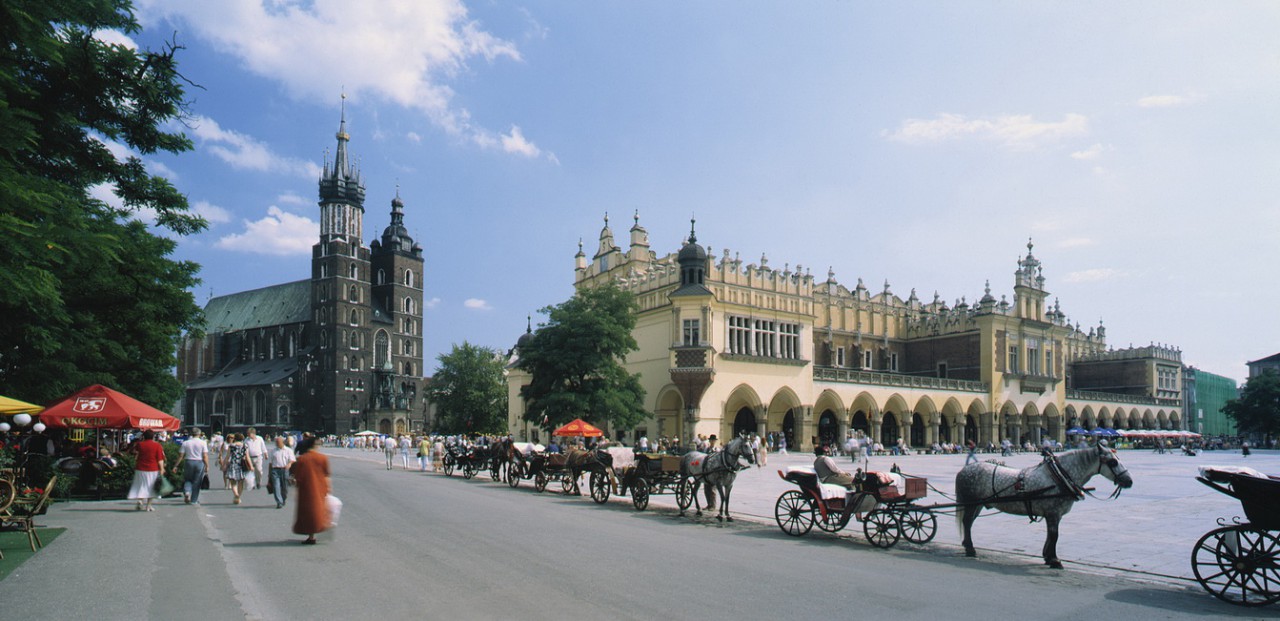
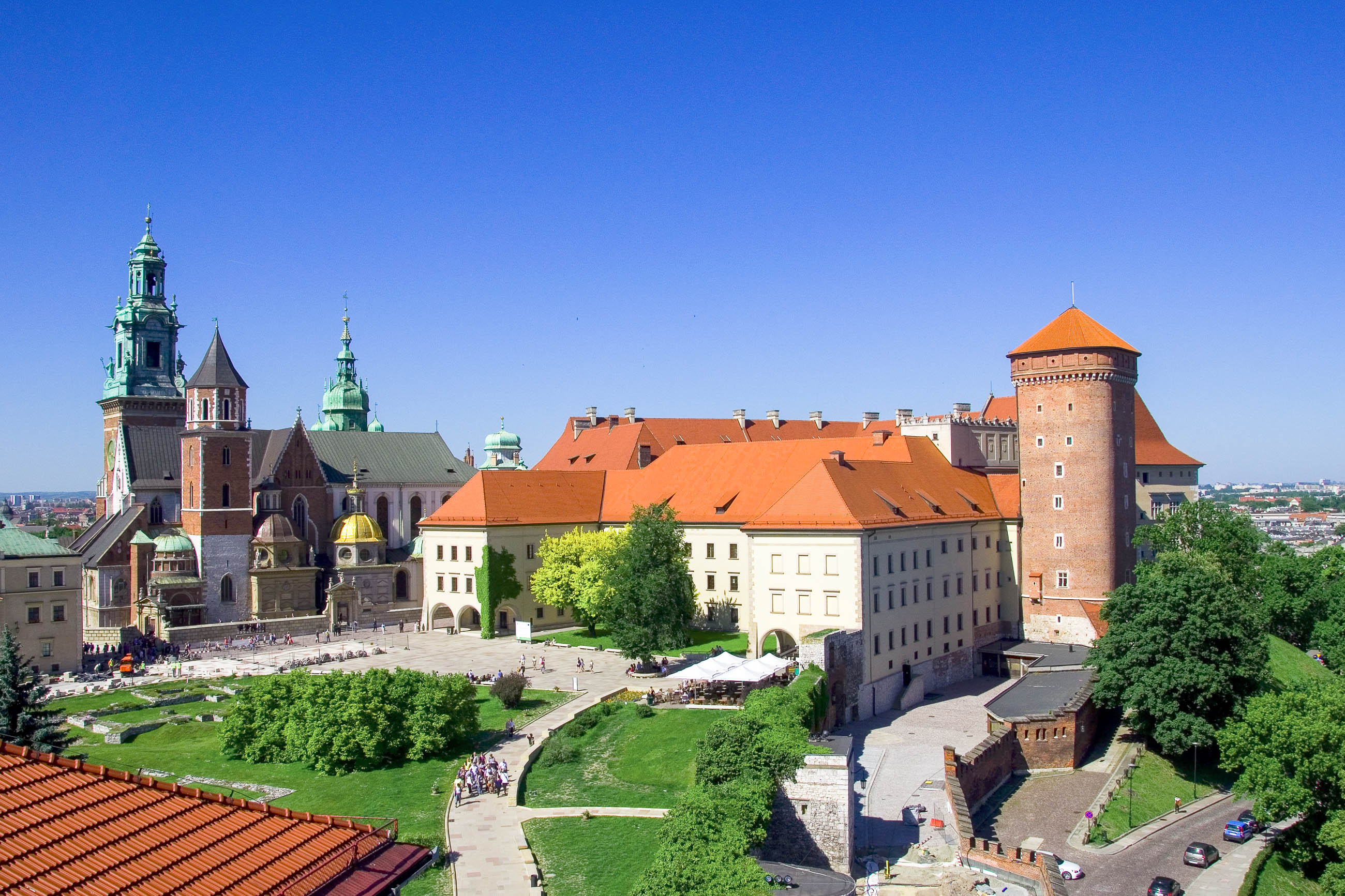
Krakau (polnisch Kraków  [ˈkrakuf]), die Hauptstadt der Woiwodschaft Kleinpolen, liegt im Süden von Polen rund 350 km südwestlich von Warschau und ist mit rund 760.000 Einwohnern die zweitgrößte Stadt des Landes.
[ˈkrakuf]), die Hauptstadt der Woiwodschaft Kleinpolen, liegt im Süden von Polen rund 350 km südwestlich von Warschau und ist mit rund 760.000 Einwohnern die zweitgrößte Stadt des Landes.
Die kreisfreie Stadt an der oberen Weichsel war bis 1596 Hauptstadt des Königreichs Polen, ist Sitz der – nach Prag – zweitältesten mitteleuropäischen Universität und entwickelte sich zu einem Industrie-, Wissenschafts- und Kulturzentrum. Zahlreiche Bauwerke der Gotik, der Renaissance, des Barock und späterer Epochen der Kunstgeschichte prägen das Stadtbild. Noch im 21. Jahrhundert wird Krakau als heimliche Hauptstadt Polens bezeichnet und gilt als das „Jahrhunderte alte Zentrum des polnischen Staatswesens“.[2] Dies zeigt sich auch an der ehemaligen Residenz auf dem Wawelhügel mit dem Schloss und der Kathedrale, wo die meisten der Könige Polens sowie zahlreiche Persönlichkeiten von herausragender historischer Bedeutung begraben sind.
Heute ist Krakau ein lebendiger Technologie- und Biowissenschaftsstandort[3] für Zentral- und Osteuropa[4] und nach Warschau der zweitgrößte Büromarkt in Polen. Krakau ist auch ein bedeutender kultureller,[5] künstlerischer und wissenschaftlicher Dreh- und Angelpunkt, z. B. mit dem Hauptsitz des Nationalen Zentrums für Wissenschaft (pl.: Narodowe Centrum Nauki),[6] dem Zentrum der Wissens- und Innovationsgemeinschaft und dem EIT. In der Nähe von Krakau befindet sich eines der bedeutendsten Filmstudios in Mitteleuropa.[7][8] Nach Angaben des World Investment Report 2011 der UNO-Konferenz für Handel und Entwicklung (UNCTAD) ist Krakau der aufstrebendste Standort für Investitionen in Innovationen der Welt.[9] Innerhalb eines 100-km-Umkreises leben etwa acht Millionen Menschen.[10]
Im Jahr 2000 war Krakau Kulturhauptstadt Europas. Krakau war einer der Austragungsorte der Volleyball-Weltmeisterschaft der Männer 2014 sowie der Handball-Europameisterschaft 2016. Außerdem war Krakau 2014 Sportstadt Europas.[11] 2016 fand in Krakau der Weltjugendtag der katholischen Kirche statt.
克拉科夫(波兰语:Kraków,波兰语发音:[ˈkrakuf](![]() 听);德语:Krakau,克拉考)是波兰第二大城市,为小波兰省首府,也是波兰的旧都。位于波兰南部,邻近克拉科夫-琴斯托霍瓦高地,维斯瓦河贯穿市区,全市人口约76万人[2]。在波兰历史上,克拉科夫自1038年起成为首都,直至1596年迁都华沙为止[3];波兰在1795年至1918年亡国期间,则以该城为中心先后建立了克拉科夫自由市及克拉科夫大公国。其拥有非法定的城市全衔,称为克拉科夫王家首都市(Stołeczne Królewskie Miasto Kraków)[4]。
听);德语:Krakau,克拉考)是波兰第二大城市,为小波兰省首府,也是波兰的旧都。位于波兰南部,邻近克拉科夫-琴斯托霍瓦高地,维斯瓦河贯穿市区,全市人口约76万人[2]。在波兰历史上,克拉科夫自1038年起成为首都,直至1596年迁都华沙为止[3];波兰在1795年至1918年亡国期间,则以该城为中心先后建立了克拉科夫自由市及克拉科夫大公国。其拥有非法定的城市全衔,称为克拉科夫王家首都市(Stołeczne Królewskie Miasto Kraków)[4]。
克拉科夫是波兰重要的旅游都市,其旧城区在1978年被列入世界文化遗产。旧城区内最重要的两处景点为中央集市广场与瓦维尔山,前者为克拉科夫之城市核心,后者则曾为波兰王室的宫殿所在。前教宗若望·保禄二世在1963年至1978年当选教宗前担任当地的总主教,当地机场在1995年以其命名。克拉科夫在2000年获选为欧洲文化之都,天主教会举办的2016年世界青年日也在此举行。
クラクフ(Kraków,  ['krakuf][ヘルプ/ファイル], 独:Krakau クラカウ, 仏:Cracovie クラコヴィー)は、ポーランド南部にある都市で、マウォポルスカ県の県都。
['krakuf][ヘルプ/ファイル], 独:Krakau クラカウ, 仏:Cracovie クラコヴィー)は、ポーランド南部にある都市で、マウォポルスカ県の県都。
ポーランドで最も歴史ある都市の一つであり、17世紀初頭にワルシャワに遷都するまではクラクフがポーランド王国の首都であった。ポーランドの工業、文化の主要な中心地でもある。ヴィスワ川の上流に位置し、市街地はヴァヴェル城(英語版)を中心として川の両岸に広がっている。
1038年から1569年まではポーランド王国、1569年から1596年までポーランド・リトアニア共和国であった。 1794年からオーストリア帝国領となり、1846年から1918年までオーストリアのクラクフ大公国であった。
人口は766,739人[2]で、これはワルシャワ、ウッチに続く第3の規模。
Kraków (UK: /ˈkrækaʊ/, US: /ˈkrɑː-/;[2][3] Polish: [ˈkrakuf] ( listen)), also spelled Cracow or Krakow, is the second largest and one of the oldest cities in Poland. Situated on the Vistula River in the Lesser Poland region, the city dates back to the 7th century.[4] Kraków was the official capital of Poland until 1596[5] and has traditionally been one of the leading centres of Polish academic, economic, cultural and artistic life. Cited as one of Europe's most beautiful cities,[6] Kraków is one of the most unique destinations in the world[7] and its Old Town was declared a UNESCO World Heritage Site.
listen)), also spelled Cracow or Krakow, is the second largest and one of the oldest cities in Poland. Situated on the Vistula River in the Lesser Poland region, the city dates back to the 7th century.[4] Kraków was the official capital of Poland until 1596[5] and has traditionally been one of the leading centres of Polish academic, economic, cultural and artistic life. Cited as one of Europe's most beautiful cities,[6] Kraków is one of the most unique destinations in the world[7] and its Old Town was declared a UNESCO World Heritage Site.
The city has grown from a Stone Age settlement to Poland's second most important city. It began as a hamlet on Wawel Hill and was already being reported as a busy trading centre of Slavonic Europe in 965.[4] With the establishment of new universities and cultural venues at the emergence of the Second Polish Republic in 1918 and throughout the 20th century, Kraków reaffirmed its role as a major national academic and artistic centre. The city has a population of approximately 760,000, with approximately 8 million additional people living within a 100 km (62 mi) radius of its main square.[8]
Cracovie (prononcer [kʁakoˈvi] ; en polonais : Kraków [ˈkrakuf] Écouter) est, avec 756 441 habitants intra muros et 1 452 496 habitants (appelés Cracoviens) avec l'agglomération, la deuxième ville de Pologne1 avant Łódź (704 000 habitants intra muros) et la Triville Gdansk-Gdynia-Sopot2. Certaines sources en particulier françaises disent que Cracovie, selon le critère du nombre d'habitants, est la deuxième ville de Pologne, mais c'est parce qu'elles ne prennent pas en compte - comme il est habituel de le faire pour les villes françaises - l'agglomération. Or de ce point de vue, Cracovie se fait devancer non seulement par Varsovie (3,304,641habitants) mais aussi par Katowice-Silésie qui, de fait, est la plus grande agglomération polonaise avec 3 029 000 habitants (ou 5 294 000 habitants pour la zone urbaine2). Il est également vrai que Cracovie étant une ville intensément et de façon permanente étudiante (180 000 étudiants enregistrés en 20153), ce qui contribue à augmenter le nombre effectif d'habitants. Il en est de même avec les touristes (10 000 000 en 20154).
Cracovia (in polacco Kraków, [ˈkrakuf] Ascolta[?·info]; in tedesco Krakau, denominazione completa Stołeczne Królewskie Miasto Kraków[1] - Città Reale Capitale di Cracovia[2]) è una città polacca di 761.873 abitanti della Polonia meridionale, una delle più antiche ed estese dello Stato. È capoluogo del relativo voivodato della Piccola Polonia dal 1999; in precedenza è stata capoluogo del Voivodato di Cracovia fin dal 1308. Inoltre è un grande centro commerciale e industriale (stoffe, pelli, macchine agricole, cartiere, editoria) e un importante nodo ferroviario.
Cracovia (en polaco, Kraków  [ˈkrakuf] (?·i)) es la capital del voivodato de Pequeña Polonia (Województwo małopolskie) y una de las ciudades más grandes, antiguas e importantes de Polonia. Situada en las márgenes del río Vístula, tiene una población de 760 000 habitantes (3 millones en su área metropolitana), lo que la convierte en la segunda ciudad más poblada de Polonia.1
[ˈkrakuf] (?·i)) es la capital del voivodato de Pequeña Polonia (Województwo małopolskie) y una de las ciudades más grandes, antiguas e importantes de Polonia. Situada en las márgenes del río Vístula, tiene una población de 760 000 habitantes (3 millones en su área metropolitana), lo que la convierte en la segunda ciudad más poblada de Polonia.1
Кра́ков (польск. Kraków (инф.) [ˈkrakuf], полное официальное название — Столичный королевский город Краков (польск. Stołeczne Królewskie Miasto Kraków, лат. Cracovia, нем. Krakau) — город на юге Польши, расположенный на реке Висле в 295 км от Варшавы. Население насчитывает 766 739 жителей (2017), вместе с ближайшими пригородами — свыше 1 млн[3]. Второй по населению (ненамного опережает Лодзь) и площади город Польши после Варшавы.[2] Административный центр Малопольского воеводства, центр архиепархии.
Столица Польши с 1038 по 1596 год, до 1734 года — место коронации польских королей. Богат историческими памятниками, центр города занесён в Список объектов всемирного наследия ЮНЕСКО. Один из крупнейших научных, культурных, экономических и религиозных центров Польши, популярное место туризма.
Культурная столица Европы в 2000 году.

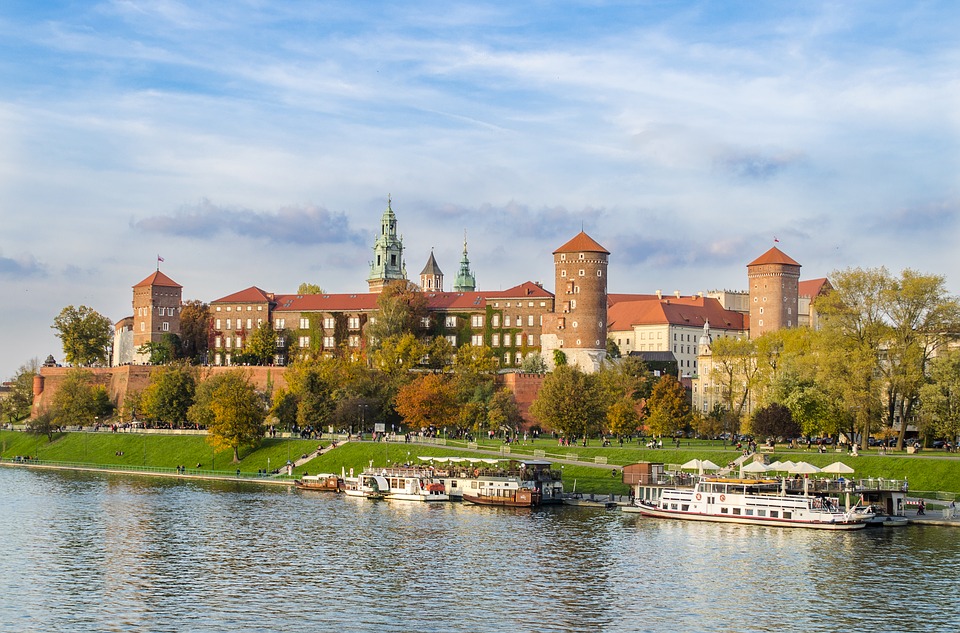
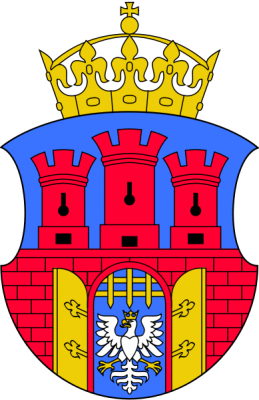
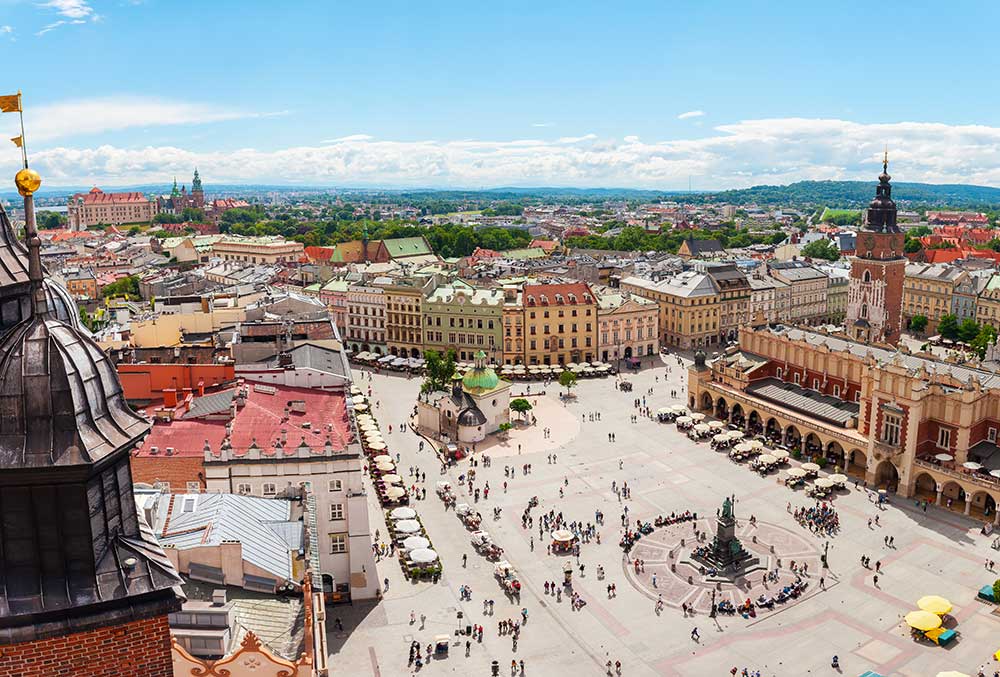
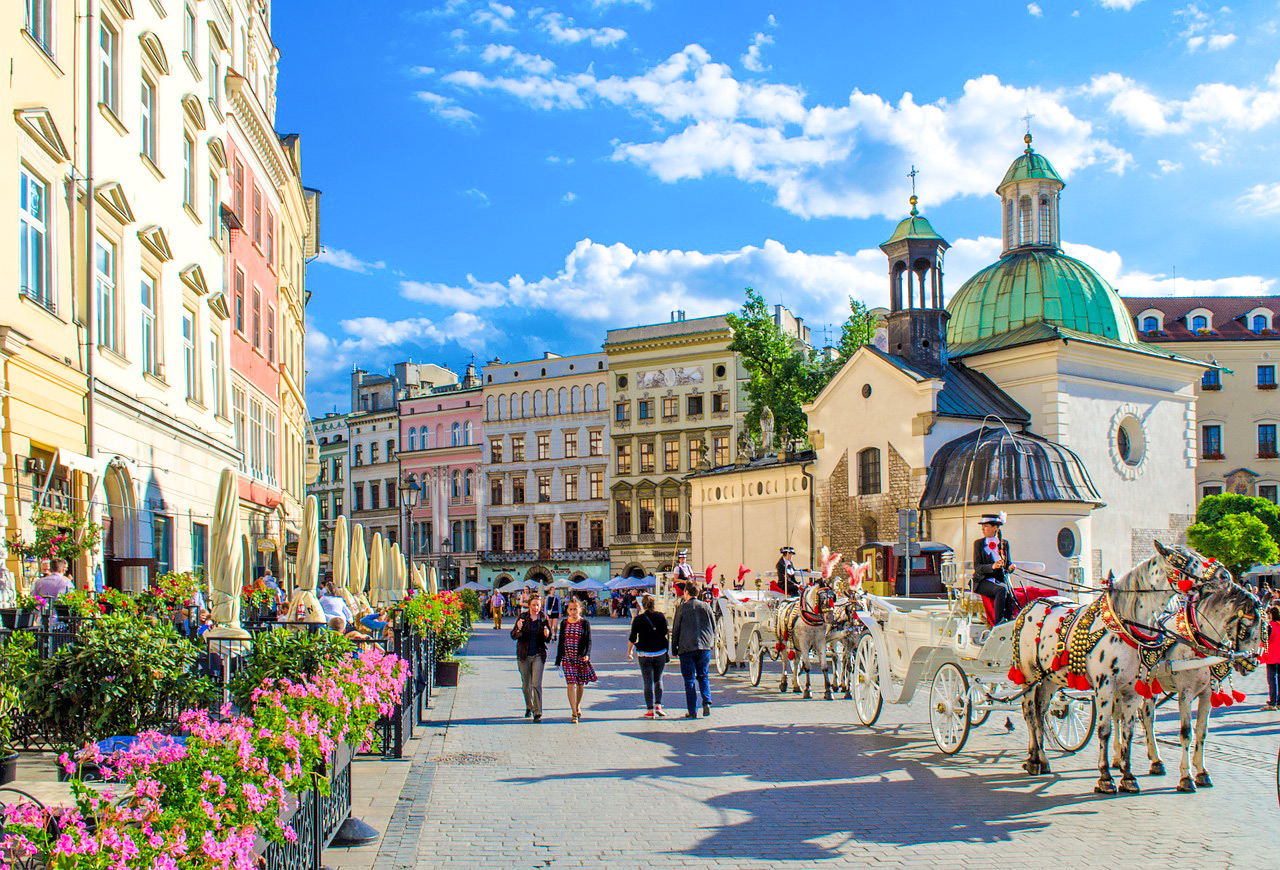




 World Heritage
World Heritage



